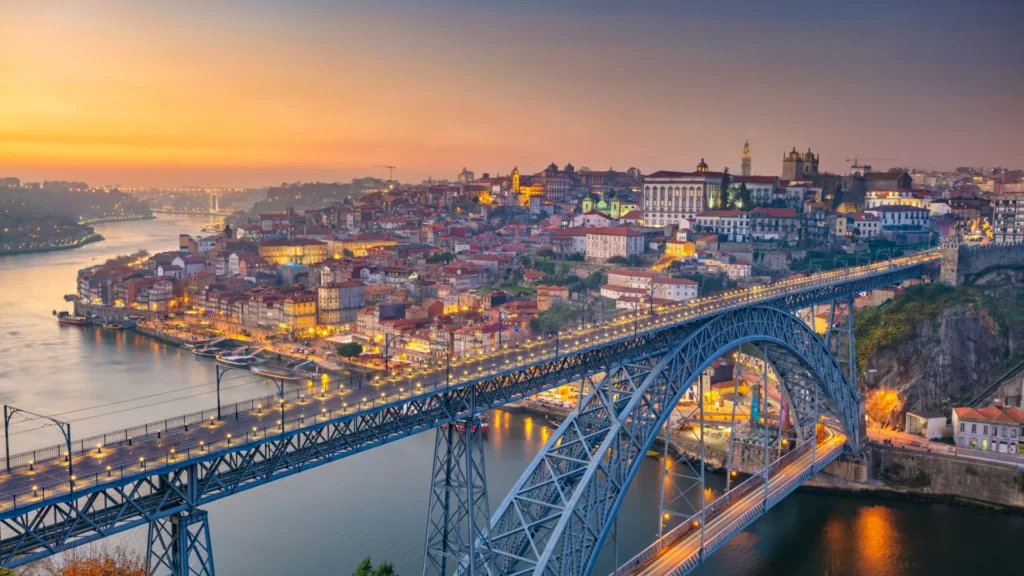
The Lifesaving Importance of Medical Alert Devices for the Elderly
As people age, the risks to their health and safety can increase significantly. From chronic illnesses and medication management t...

Seniorcenters.com is a free resource helping seniors and senior centers across America. Learn about our editorial processes.
Porto, Portugal’s second-largest city, is a captivating destination rich in history, culture, and scenic beauty. Situated along the Douro River, this charming city offers a delightful blend of old-world charm and modern comforts, making it an ideal destination for senior travelers seeking a leisurely and enriching experience.
Porto’s history stretches back to Roman times, playing a pivotal role in Portugal’s maritime discoveries and trade. While Lisbon is the nation’s capital, Porto has been a significant economic and cultural hub. Notably, during the 12th century, Porto contributed to the country’s independence and expansion. The city’s historic center, Ribeira, is a UNESCO World Heritage Site, showcasing medieval architecture and narrow cobblestone streets that echo tales of the past.
Although Porto has never officially been the capital, it has been instrumental in shaping the nation’s history. Its strategic location made it a vital port for commerce and exploration during the Age of Discoveries.
Porto boasts a dynamic urban landscape, both within its city limits and its extensive metropolitan area. Understanding the distinction between the city proper and the metropolitan region provides a clearer picture of Porto’s scale and vibrancy.
Metropolitan Area: Expanding beyond the city center, Porto’s metropolitan area encompasses around 1.4 million people. This broader region includes surrounding municipalities, enhancing Porto’s cultural and economic significance. Comparatively, the metropolitan area aligns more closely with cities such as:
City Proper: With a population of approximately 240,000 residents, Porto offers a more relaxed atmosphere compared to larger cities. It’s comparable in size to cities like:




Porto is renowned for its picturesque landscapes and architectural marvels. The cityscape is adorned with:
Porto is synonymous with port wine, a sweet fortified wine produced exclusively in the Douro Valley. The Vila Nova de Gaia district across the river hosts numerous wine cellars like:
Visitors can enjoy guided tours and tastings, learning about the centuries-old winemaking traditions that have made port wine famous worldwide.
A Storied History
The origins of port wine date back to the 17th century when British merchants sought a solution to prevent wine spoilage during long sea voyages to England. By adding aguardente (a type of grape spirit) to the wine, they not only preserved it but also created a sweeter, more robust beverage that could withstand the journey. This method inadvertently gave birth to port wine, establishing a lasting legacy that continues to define Porto today.
The Douro Valley: Heart of Port Wine
The Douro Valley, a UNESCO World Heritage Site, is renowned for its terraced vineyards that cascade down steep hillsides alongside the Douro River. The region’s unique microclimate, characterized by hot, dry summers and cold winters, combined with its granite and schist soils, imparts distinctive flavors and aromas to the grapes. The meticulous cultivation and harvesting practices, often performed by hand, ensure the highest quality for port production.
Iconic Wine Cellars in Vila Nova de Gaia
Situated across the Douro River, the Vila Nova de Gaia district is home to some of the most prestigious port wine cellars in the world. These cellars not only store and age port wine but also serve as cultural landmarks where visitors can immerse themselves in the art of winemaking.
The Art of Port Production
Port wine production is a harmonious blend of tradition and precision. The process begins with the careful selection of grape varieties, primarily Touriga Nacional, Touriga Franca, and Tinta Roriz, among others. After harvesting, the grapes are fermented, and aguardente is added to halt fermentation, preserving the wine’s natural sweetness and boosting its alcohol content.
Aging is a critical phase that defines the port’s character. There are several styles of port, each with distinct aging processes:
Cultural Significance and Festivals
Port wine is more than just a beverage in Porto; it’s a cultural emblem celebrated through various festivals and traditions. The annual Porto Wine Festival showcases the region’s vinicultural heritage with tastings, parades, and music, attracting enthusiasts from around the globe. Additionally, many local restaurants and bars feature live Fado music, creating an immersive experience that pairs the soulful melodies with exquisite port selections.
Educational Tours and Tastings
Visitors to Porto can embark on comprehensive tours that offer an in-depth understanding of port wine production. These tours typically include:
Sustainability and Innovation
Modern port houses are increasingly embracing sustainable practices to preserve the Douro Valley’s delicate ecosystem. Initiatives include organic viticulture, water conservation, and renewable energy usage within the cellars. Additionally, technological advancements are being integrated into traditional processes to enhance efficiency without compromising the authenticity of port wine.
Notable Anecdotes and Legends
Port wine heritage is rich with fascinating stories and legends. One such tale involves the mysterious “Night of the Port,” where traders would secretly transfer barrels of port across the river to evade taxes and regulations. This clandestine activity not only ensured the wine’s safe passage but also contributed to the unique flavors developed during transport.
Another legend speaks of the “Port Wine King,” a mythical figure believed to oversee the vineyards and ensure the quality of each vintage. While purely mythical, this figure symbolizes the deep respect and reverence the people of Porto have for their beloved port wine.
Conclusion
Port wine is the lifeblood of Porto, weaving together history, culture, and craftsmanship into every bottle. Exploring the port wine heritage offers a profound appreciation for the region’s traditions and the meticulous artistry that elevates port wine to its esteemed status worldwide. Whether you’re a seasoned connoisseur or a curious traveler, Porto’s port wine cellars invite you to taste, learn, and celebrate this timeless elixir.
Airports and Flights
Porto is generally walkable, especially along the riverfront and in central areas. However, the city is built on hills, and some streets are steep. Tips for seniors:
For proximity to attractions and ease of mobility, consider staying in:
These areas are well-connected and within walking distance to many attractions, making them ideal for seniors seeking convenience and comfort.
Understanding Porto’s weather patterns can help you pack appropriately for a comfortable trip. Below is a chart outlining the average weather conditions and clothing recommendations for each month:
| Month | Avg High °C (°F) | Avg Low °C (°F) | Rainfall (mm/in) | What to Wear |
|---|---|---|---|---|
| January | 14°C (57°F) | 5°C (41°F) | 150 mm (5.9 in) | Warm layers, coat, umbrella |
| February | 15°C (59°F) | 6°C (43°F) | 120 mm (4.7 in) | Jacket, rain gear |
| March | 17°C (63°F) | 7°C (45°F) | 100 mm (3.9 in) | Light layers, waterproof jacket |
| April | 18°C (64°F) | 9°C (48°F) | 90 mm (3.5 in) | Light jacket, comfortable clothes |
| May | 20°C (68°F) | 11°C (52°F) | 80 mm (3.1 in) | Spring attire, light sweater |
| June | 23°C (73°F) | 14°C (57°F) | 40 mm (1.6 in) | Short sleeves, hat, sunscreen |
| July | 25°C (77°F) | 15°C (59°F) | 20 mm (0.8 in) | Summer clothes, sunglasses |
| August | 25°C (77°F) | 15°C (59°F) | 30 mm (1.2 in) | Light attire, comfortable shoes |
| September | 23°C (73°F) | 14°C (57°F) | 60 mm (2.4 in) | Light layers, possible rain jacket |
| October | 21°C (70°F) | 12°C (54°F) | 100 mm (3.9 in) | Light jacket, umbrella |
| November | 17°C (63°F) | 9°C (48°F) | 150 mm (5.9 in) | Warm layers, rain gear |
| December | 14°C (57°F) | 6°C (43°F) | 160 mm (6.3 in) | Coat, scarf, waterproof clothing |
Recommendations:
Navigating Porto is convenient with a variety of transportation options:
Porto and Lisbon, Portugal’s two major cities, are well-connected through various transportation modes:
Porto is considered safe for tourists, including senior travelers. However, standard precautions are advised to ensure a pleasant and secure visit:
Porto’s rich history, stunning architecture, and warm hospitality make it a delightful destination for senior travelers. With its walkable neighborhoods, accessible attractions, and vibrant culture, Porto offers an unforgettable experience that caters to leisurely exploration and cultural enrichment. Whether you’re savoring a glass of port wine, strolling through historic districts, or enjoying the scenic river views, Porto welcomes you to discover its timeless charm.
No results available
Browse thousands of Senior Centers from around America. Senior Centers are an integral part of society and are the center of life for many seniors and aging adults.
Find a Senior Center which fits your needs using our search feature and keep up to date on all the latest news.
Click the icon to Ask Anything!
Advertisers are not endorsed by SeniorCenters.com or any senior center listed.
This site is not endorsed by or affiliated with any senior center or organization listed.
Just one helpful email per month – no clutter, just value.